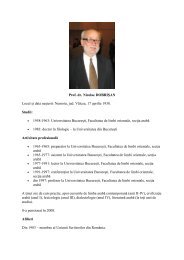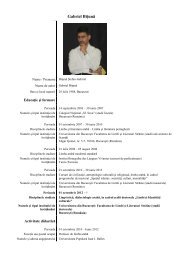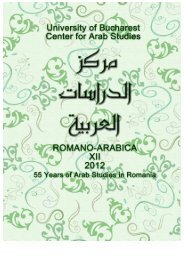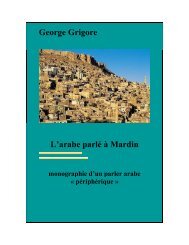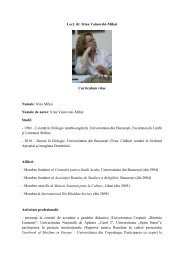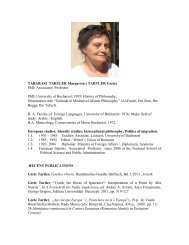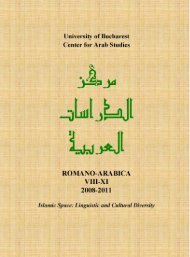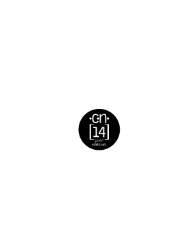University of Bucharest
University of Bucharest
University of Bucharest
Create successful ePaper yourself
Turn your PDF publications into a flip-book with our unique Google optimized e-Paper software.
periods. For e.g. meleh~īn ―kings‖, Proverbs 31, yam×n ―days‖, Daniel 12, 13, etc.<br />
(Gezenius 1874: 332).<br />
In the element -ī - mīm is dropped. As for -ām it is a rarely used archaic<br />
form sullam < salal ―stairs‖ (Gezenius 1874: 332).<br />
The feminine plural is constructed with the suffix -ōt. If in singular the<br />
feminine noun ends with -ōt//īt, in the feminine form īm is added: almenūtīm<br />
―widowhood‖, ―widows‖.<br />
Some words have double plural forms. This lexeme ending with ōt in<br />
plural additionally receives -im//īm: h}ōma ―wall‖ > h}ōmōt > h}ōmōtīm (Gezenius<br />
1874: 335).<br />
Some words we find only in plural forms, for e.g.: metīm ―people‖,<br />
―human beings‖, ―mortal‖, elōhīm ―God‖ are presented only in the plural form.<br />
In addition to Ugaritic and Hebrew, the element -m/-īm is characteristic in<br />
Phoenician (īm). With regard to Aramaic and Ethiopian, in these languages<br />
consequently is found īn and ān forms. In Classical Ethiopian the element <strong>of</strong><br />
feminine plural -āt is found in masculine nouns as well: kāhem-kāhenāt ―priest‖,<br />
falāsefāt ―philosophers‖. In Arabic in indirect cases, as we know we have ending<br />
-īn and in Nominative case we have ending -ūn.<br />
In Akkadian, plural masculine forms are constructed with -ē, -ani, -ānu, ūti,<br />
and less <strong>of</strong>ten with ū. For e.g.: sisē ―horses‖, ilāni ―Gods‖, duppānu ―earthenware<br />
plates‖, rabūti ―big‖, tabbanūtu ―buildings‖, paršū ―decisions‖. Feminine plural in<br />
Akkadian is constructed with suffix -ātī.<br />
Mimation is typical for Akkadian. The names in status absolutus receive -<br />
m and sometimes it is replaced with -ma. We also find parallel forms without<br />
mimation in the language: bītum//bītu ―house‖, rieum//rieū ―shepherd‖. Predictably<br />
mimation is dropped in the words in status constuctus and with pronominal suffix<br />
forms. Mimation is also characteristic for Epigraphic South Arabic, where an<br />
indefinite noun ends with (-m).<br />
4.0. To explain the plural form <strong>of</strong> mīm in QAD dialect I believe we must<br />
consider linguistic factors as well as extra-linguistic ones.<br />
In my opinion the existing toponym in the Karshi area <strong>of</strong> the Qashqa-daryā<br />
side is noteworthy, and is linked to the old Arab tribe in the area. Qakhlai must be<br />
distinguished, as it derives from qah}tān and is an indication <strong>of</strong> southern Arab tribe.<br />
Arabs from the Arab Peninsula in the pre-Islamic period were divided into<br />
two groups: Arabs <strong>of</strong> pure blood (al-‗arab al-‗arība) and non-native Arabs, i. e.<br />
assimilated Arabs (al-‗arab al-musta‗riba). There existed a third group <strong>of</strong> Arabs,<br />
which were unified groups <strong>of</strong> Aramaic descent (al-bā‘ida = ―lost‖, ―unknown‖).<br />
The pure Arabs (al-‗arība) related themselves to the yoktān, i. e. qah}tān. Joktan<br />
(Qahtan) was the son <strong>of</strong> Eber. He was a founder <strong>of</strong> the southern Arab tribe <strong>of</strong><br />
34



